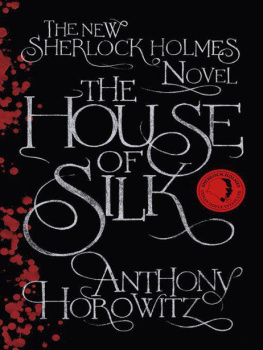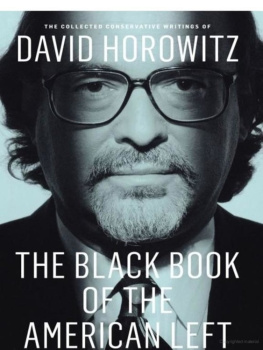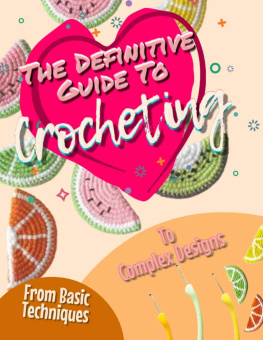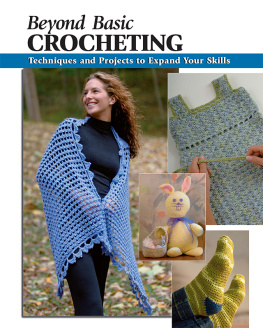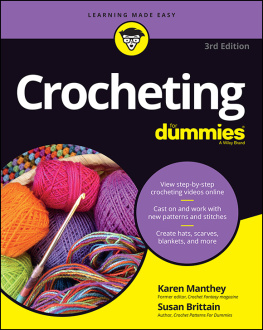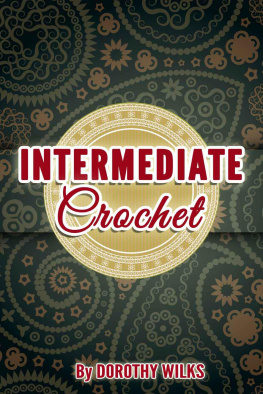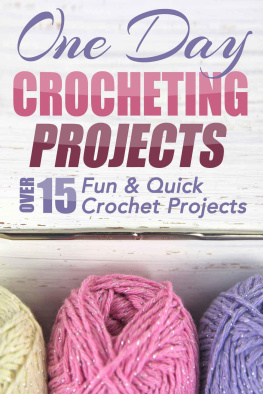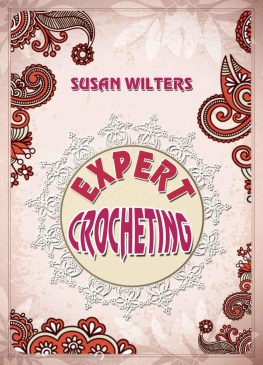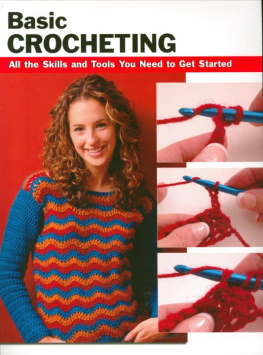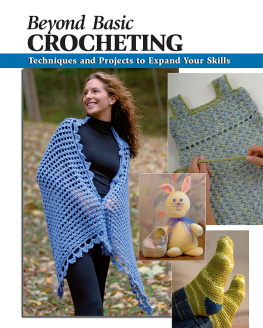This book is dedicated to mygrandmother Beatrice. She passed down crochet skills that are second to none.
Chapter 1- What Are the Basics of How to Crochet?
Learninghow to crochet is simple once you master the basics. Crochet patterns areeasy-to-follow, and most require very few materials to complete. Once you havelearned the art of crochet, you can even take your projects along with youanytime you expect to have extra time on your hands. Crocheting is also arelaxing hobby that can be used to create many useful household projects andgifts. If you are ready to get started learning how to crochet, then here is anoverview of the basic techniques you need to know.

Choosingthe Right Materials
Crochetprojects can be completed using many different types of material. Plastic, ropeand even paper have successfully been crocheted. Yarn and thread are the twomain types of crochet materials that most patterns will require. Although mostpatterns will list the right type of yarn to use, it is helpful to understandthe types of yarn along with the projects for which they are best suited.
Worstedweight yarn is the most common type of yarn that will be called for in apattern. This type of yarn is used for blankets, scarves and other projects. Babyweight yarn, also called fingering weight, is thinner and softer than worstedweight. This yarn is usually used for baby blankets and other projects wheresofter yarn is needed. Variegated yarn is made from either types, but itincludes varying colors along the strand. This yarn can be used to create amulti-colored project without having to change colors. Crochet thread isthinner than yarn and resembles string. It is most often used when crochetingdoilies and other lacey projects.
Selectingthe Appropriate Hook
Thetype of hook that you use will vary, however aluminum hooks are the go-tochoice when creating a project made with regular yarn. Steel hooks are smallerand ideal for making projects with thread. Special hooks, such as Tunisian andlong-handled ones can be used to create special projects that call for advancedtechniques. Plastic hooks are best for large projects that use chunky yarn.
Learningto Read a Pattern
Forthose who are just learning crochet, reading a pattern can seem as if you aretrying to understand a different language. Do not worry; crochet abbreviationsare easy to learn and will make reading patterns easier once you get the hangof it. Here, are a few basic abbreviations you will see when doing beginnerpatterns:
Ch-chain
Sc-singlecrochet
Dc-doublecrochet
St-stitch
Yo-yarnover
Beg-beginning
Itis also important to know that anything included in brackets will be a set ofinstructions that should be completed as many times in a row as indicated. Anasterisk will also be used to indicate that a set of instructions should befollowed before completing the next stitch.
Howto Hold the Yarn and Hook
Holdingthe hook properly is as simple as holding a pencil, yet it can take somepractice to master the use of it for crocheting. Begin by holding your firsttwo fingers against your thumb. Then, place the hook in your dominant hand asyou would a pencil. To begin crocheting, you should have the hook portion ofthe handle facing you.
Withthe hook in hand, you will be ready to learn how to hold the yarn. Aftercasting on, you will hold the yarn in your opposite hand by allowing it to runover and under your first finger. Use your thumb to adjust the tension of theyarn by placing it against the yarn on the underside of your finger. This partof crochet can be challenging at first, but it will eventually become secondnature.
Beginninga Project
Onceyou have gathered your materials and mastered holding the hook and yarn, youwill be ready to begin a project. Every project begins by performing atechnique called casting on. This is done by making a loop with your yarn andpassing the hook through the loop to catch the yarn. After you yarn over,simply draw the hook back through the loop. Pull on the loose end of the yarnto create a knot on the hook. Now, you are ready to follow the pattern.
Followingthe Pattern
Mostcrochet patterns are worked in rows that will move horizontally, yet they canalso be worked in rounds. Begin the pattern on the first row and then work yourway through until the project is completed. Generally, each row will include aninstruction for how many chains to make and to turn. However, pay carefulattention to this section because some projects require you to continue workingon the same side. This is very common when working rounds.
FinishingOff
Afteryou have worked all of the rows, you will be ready to finish off your project.This is done by snipping the yarn after the last stitch. Be sure to leave extrayarn during this step. Then, draw the thread through the final loop and pull ittaut. There should be a small knot. Weave the remaining thread into the lastfew stitches and enjoy your finished work.
Masteringthe basics of crochet will take some time, yet your efforts will be rewarded bybeautiful finished projects. Then, continue to learn new stitches andtechniques that can be used to create different patterns in your work. Bylearning new skills, you will continue to develop in your craft while openingup even more opportunities for completing advanced patterns.
Chapter 2- What Are the MostImportant Crochet Supplies to Have?
Oneof the best things about crochet is that you do not really need many tools whenyou first start. A simple aluminum crochet hook, a pair of scissors, and askein of worsted yarn are all you normally need to tackle your first beginnerlevel project. However, as the crocheting bug starts to draw you in, you willfind yourself quickly accumulating various tools and numerous skeins of yarn inanticipation of future projects. If you find that you really enjoy crocheting,there are some important supplies to keep on hand to help with your new hobby.
CrochetHooks
Walkinto any craft store or look online and you will see that not only do crochethooks come in various sizes; they are made from different types of materialssuch as steel, aluminum, plastic, and bamboo. What you should choose to add toyour stash of supplies depends on a few factors such as the type of crochet youplan to do, the materials you are using, and the weight of the hook.


